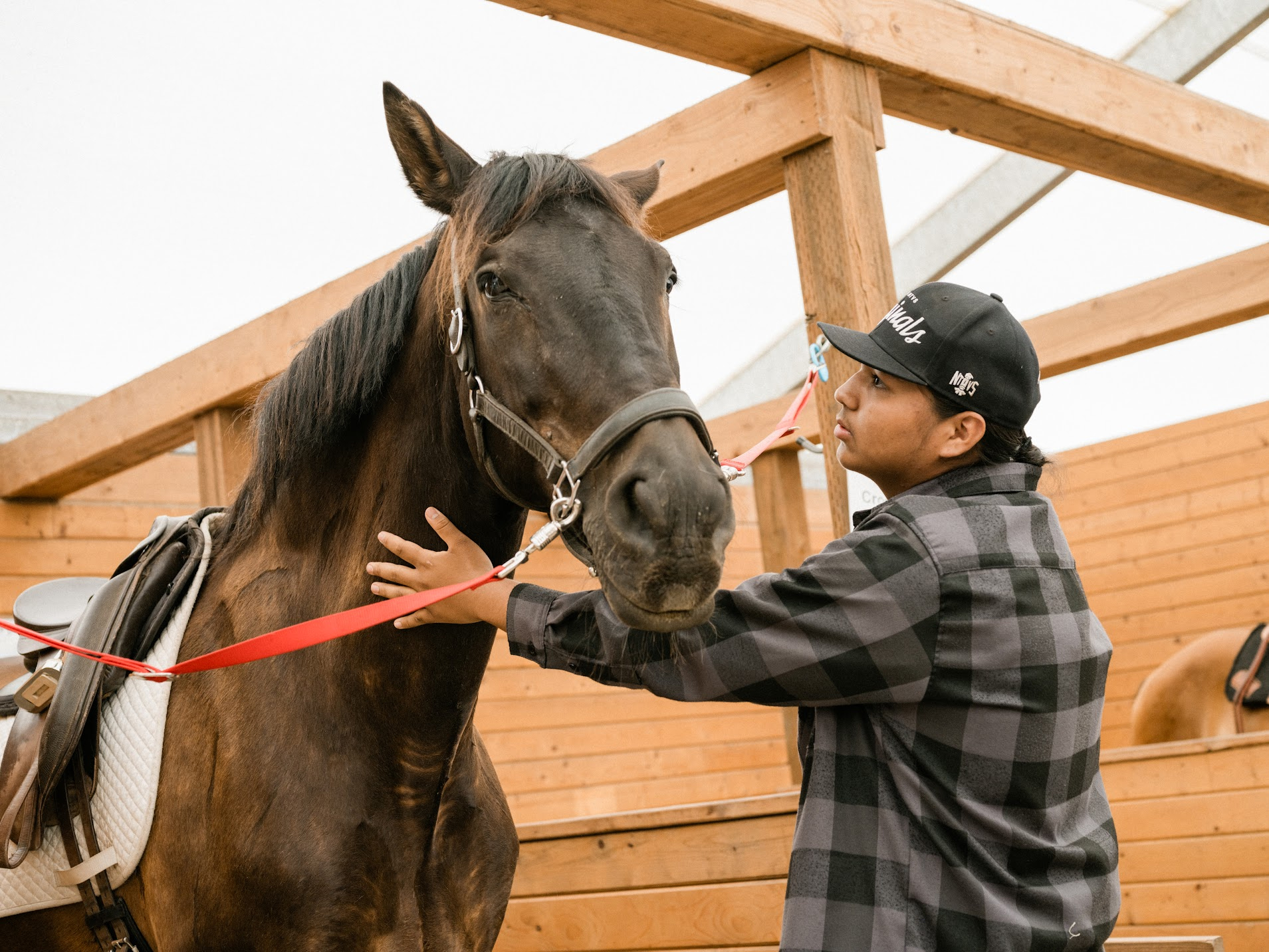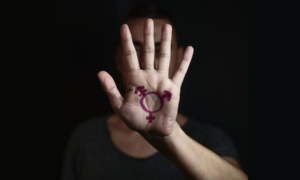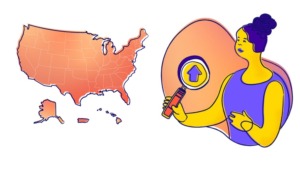Healing the children of Horse Nations was co-produced by The Imprint and the community news site Voices of Monterey Bay.
Surrounded by prairie grasses and dogwood trees, a half-dozen young people ages 10 through 16 clasped hands at the Forward Stride ranch on a muggy morning last summer. The tribal youth gathered to recover from harmful experiences with drugs, alcohol and incarceration had some noteworthy guides: Dusty, Dakota, Sunny, Storm and Spirit. The snickers, snorts and stomps of this plucky group of spotted Appaloosas and paint horses echoed across this Beaverton, Oregon expanse like a drum, rhythmic and soothing.
One boy, a 10-year-old, closed his eyes as he bowed his head to pray with the others who gathered in a circle, clutching hands. They had spent much of the past hour brushing silky hides and combing caramel-colored manes before hoisting themselves into stirrups and saddles on the horses’ firm backs.
After a good ride on a horse named Rune, the boy was ready to give back to his equine guide, who he said made him happy during their time together. The saunter left the gelding horse struggling a bit with humidity and an abundance of flies. The child asked the spirits to “please make my buddy, Rune, feel better.”
Other participants shared this sense of relief and tenderness at the end of the day’s treatment session on the Forward Stride ranch. During a debriefing conversation at the end of the July 25 treatment session, one teen said: “The horses made my problems go away.”
“They’re like my best friends,” said another.
Oregon’s Indian Country harnesses the power of equine therapy for its children leaving foster care and juvenile justice systems
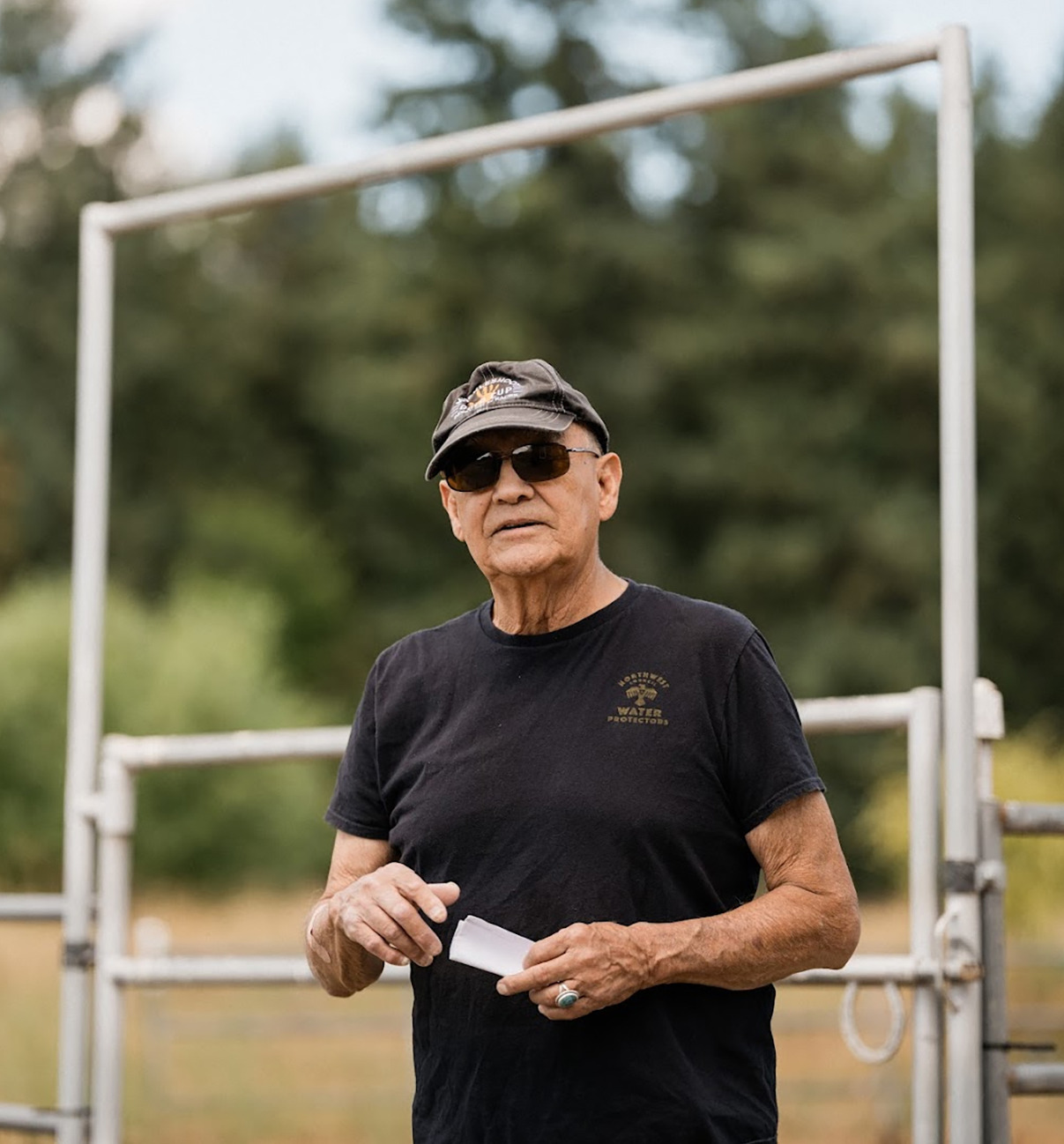
Josué Rivas/The Imprint
John Spence (Gros Ventre/Sioux), known to many as Uncle John, is an 82-year-old elder who’s had a long career in social work and now advocates for horse therapy in tribal communities.
These sentiments are the goal, says John Doug Spence, 82. Spence is a member of the Gros Ventre tribe, who leads the treatment program at Forward Stride ranch. Twice a week, Spence shepherds between five and 12 youth participants to his Indigenous-centered equine therapy sessions to experience firsthand what he summarizes as the “healing power of horses.” Since 2003, the Forward Stride Horse-Centered Activities and Therapies program has served Indigenous children and teens in foster care, the juvenile justice system or in recovery from substance or alcohol dependency through a method that is closely aligned with their culture and traditional practices. It became a nonprofit in 2015.
“Horses take us all the way back to our history before land was taken away,” Spence told The Imprint on a July visit to the ranch. “It’s a way of taking back our power.”
The Forward Stride sessions are among a growing number of similar equine-centered treatment programs that Spence has contributed to in the area, part of what he described as “a movement towards Indigenizing therapy options” for struggling youth on reservations and in foster care. Two Oregon tribes, Confederated Tribes of Umatilla Indian Reservation, and the Confederated Tribes of the Warm Springs have developed similar programs in the last three years. The Confederated Tribes of Grand Ronde, Klamath Tribes and Burns Paiute Tribe have plans to launch treatment programs with horses.
Proponents say the benefits are myriad for members of these Horse Nations — tribes that considered the stately animals sacred partners. Horses provide a way for Indigenous youth to strengthen kinship bonds between animals, their people and the land they’ve shared — and to soothe hardships in their lives, Spence said. Caring for horses also promotes healthy habits and positive relationship skills: Trust is required to work closely with beings that can weigh more than 1,000 lbs. and tower well above a small child.
So for the last dozen years, Spence has met every Tuesday with at-risk Indigenous boys in treatment, and every Thursday with girls. And through that work, he is continually working on his healing as well, he said in a series of interviews by phone and in person over many months. A longtime social worker, Spence is the author of a 2021 memoir, “Crazy Wolf: A Half-Breed Story.” The book chronicles his journey to recover from a troubled childhood, after being wrenched from his tribe by the federal government’s Relocation program.
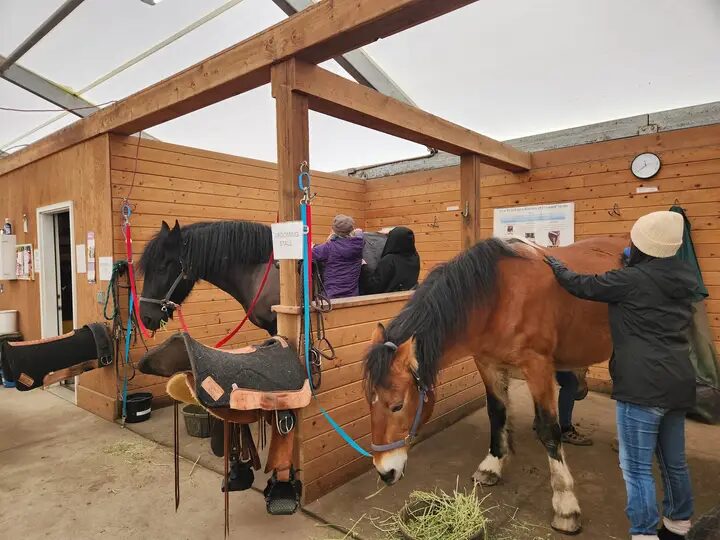
Desiree Willow Sam/The Imprint
John Spence spends each Thursday working with Indigenous girls in treatment for substance use, alcohol dependency or involvement with the justice system.
Connecting with horses was essential for his own recovery from 38 years living with alcoholism, he writes. Spence had lost his wife of 22 years, and the horse he had at the time, named Koda, was his “healer” during that period of grief.
Now in his eighth decade, Spence is more convinced than ever of horses’ ability to guide young people through similar struggles.
“It’s really an honor, but at the same time, really humbling, to be part of horse therapy across Oregon’s Indian Country,” he said.
Contrary to prevailing theories, oral histories and archaeological remains reveal evidence of horses in North America well before European settlers arrived, according to a March study published in the journal Science authored in part by experts from Pueblo, Pawnee, Comanche and Lakota nations.
Lakota elder Jon Eagle, Sr. developed the “Becoming One with the Spirit of the Horse” curriculum that has inspired Spence and members of other Oregon tribes. The approach runs counter to Western ways of interacting with the animals. Instead of “breaking” a wild stallion, a horse is “gentled,” through attention to body language, reins-free movements and earning a horse’s trust.
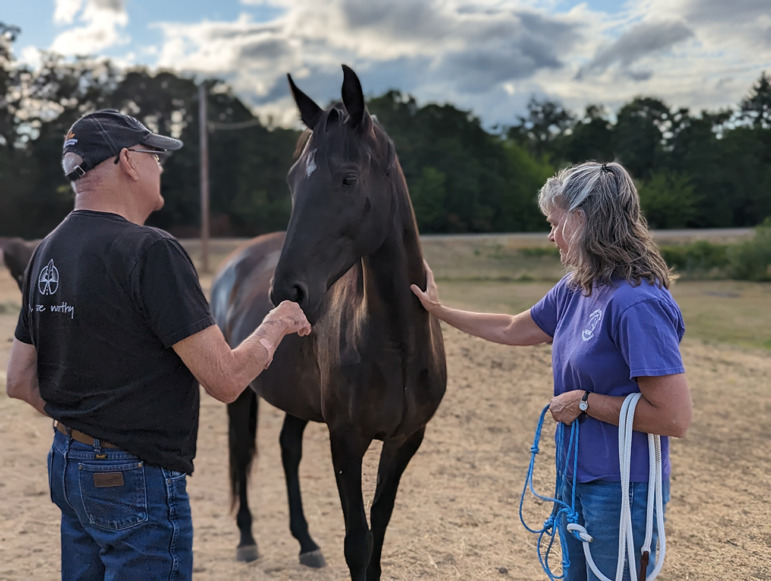
Nancy Marie Spears/The Imprint
John Doug Spence, left, and Debbie Driesner, right, stand next to Traveler, one of Driesner’s rescued wild mustangs on her ranch near Dulles, Oregon.
This method is derived from reciprocal relations Native peoples have long shared with other animals. Before colonization and the introduction of fences, horses and their foals lived alongside tribal people. Horse Nations based in the Great Plains and Pacific Northwest, relied on the animals for transport, hunting and help in battle.
Their role as healers among Native people worldwide is increasingly well documented. For this article, The Imprint identified six studies describing equine therapy’s benefits for tribal youth entangled with criminal justice or foster care systems, as well as children who’ve experienced trauma and abuse.
“Equine-assisted services (EAS) are gaining popularity as ways to promote psychological health and social well-being … for at-risk Indigenous youth.”
Frontiers in Public Health
Horse therapy programs aren’t unique to tribes in Oregon. Numerous tribes across the country are nurturing the power of kinship with animals as a unique and effective way to heal.
“Horse therapy on the reservation is quickly becoming an accepted and effective method of treating trauma for Native American children and teens,” the Native Hope blog stated. Among them is the Tiwáhe Glu Kiní Pi ranch on the Rosebud Sioux Reservation in South Dakota. The tribe’s weekly program “Bringing the Family Back to Life” serves children and adults.
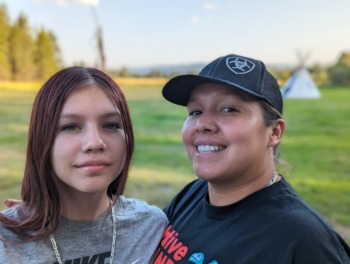
Nancy Marie Spears/The Imprint
Desiree Willow Sam, right, and her daughter Peyton Larae Sam.
“Equine-assisted services (EAS) are gaining popularity as ways to promote psychological health and social well-being,” states one article, a 2022 study published in Frontiers in Public Health that relied on 27 additional studies in Canada, Australia, New Zealand and the United States. They show “particular promise as culturally appropriate initiatives for at-risk Indigenous youth, as they are thought to align well with Indigenous ways of knowing which place emphasis on relationships between the land and all living beings.”
Desiree Willow Sam, a social services mental health assistant for the Burns Paiute tribe, is helping to develop horse therapy programs for her community. She grew up around horses and knows well their healing capacity, particularly for children who have been adopted or are living in foster care, where wounds are often compounded by separation from kin and community.
“I’m ready to hurry up and get the program started, because horses are in our DNA, they’re in our culture and our heritage,” Sam said. “Whether they’re with their own families or not, that horse can bring peace to them. Horses can bring healing to a part of their heart. That feeling is culturally tied, because it’s in all of us.”
Spence did not grow up with horses, he explained, while driving through mountainous terrain in eastern Oregon en route to the Burns Paiute reservation — save for rare occasions he rode with an uncle on the Fort Belknap reservation in Montana. He worked as a ranch hand for his stepfather at age 18. And later in life, spent a decade and a half participating in all-Indigenous rodeos.
Spence knew who his biological father was, but they never met. He and his two sisters lost their mother when she was struck and killed by a mail truck in 1944 in Seattle where she had been working at a defense plant. At the time, her kids were with their grandmother in Harlem, Montana, just south of the Fort Belknap reservation. When Spence’s mother died, the surviving relatives moved to a low-income housing project in south Seattle.
The family has a long history of forced displacement. Spence is a child of boarding school survivors, and he and his descendants were robbed of their lands and livelihoods under the 1956 Indian Relocation Act.
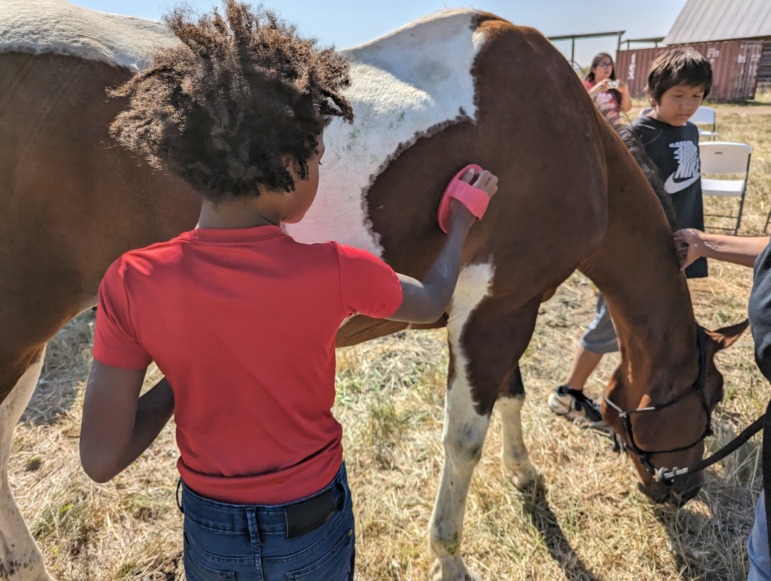
Nancy Marie Spears/The Imprint
A young person participating in Burns Paiute’s equine therapy brushes Apache, a paint horse.
In the 1970s he found a way to overcome, becoming steeped in “guerilla social work,” which Spence’s memoir describes as “unconventional actions from the heart and fearless advocacy for the poor.”
Spence fostered a daughter as well as his son, who received three horses as a gift from a cousin on the Fort Belknap reservation. Throughout his young adult life and while raising kids, Spence dreamed about horses — riding them, grooming them, speaking with them.
The synergy with his social work came in 2009, when he began volunteering for the Mustangs Offering Hope and Renewal ranch, a nonprofit that rehabilitates rescued wild horses. At one point, a tribal social worker asked if a Native child in foster care could visit with the horses. Spence and his friend Debbie Driesner, who ran the mustang rescue, said, “Of course.”
Funding for the Forward Stride therapeutic program has come from the federal Substance Abuse and Mental Health Services Administration and the Native American Rehabilitation Association of the Northwest — an organization that provides culturally appropriate educational, mental and physical health and substance dependency services. Spence has welcomed local foster youth ever since.
“Horses were and still are healing for me, and I’m energized by the way I’m seeing it’s healing for these kids,” he said. “I want them to have that chance at a healthy life, earlier than I did.”
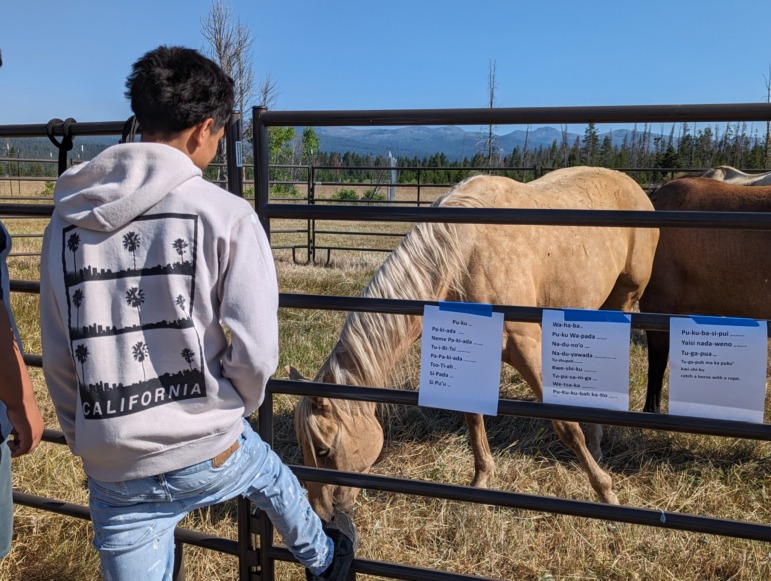
Nancy Marie Spears/The Imprint
Horse trainers incorporate Paiute language lessons into the equine therapy program, connecting young people with the culture and traditions of Horse Nations.
At the outset of each session, Spence coaches young people to speak to the horses respectfully. There is no shouting at the horse. Instead, youth are encouraged to engage with them like they would with their friends and others they love.
There is no hard tugging or vocal frustration when the horse doesn’t seem under their control, he tells the assembled children. Use simple verbal commands, not smacks, to guide the horse, Spence explains: “Walk on” asks the horse to move forward, and “Hmm, whoa,” tells the horse to stop.
During the grooming period, children giggled as the horses huffed, spewing hot breath so powerful it rustled the kids’ hair.
Some participants — those new to horses — were initially skeptical. Others found a familiar source of comfort. But they all trudged off into the covered arena, veering the steeds around strategically placed barrels and smiling, growing ever more confident with each trot.
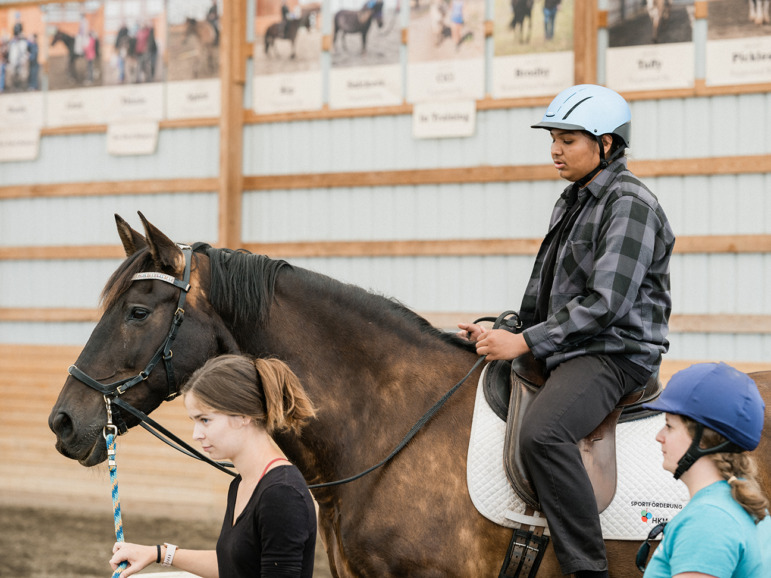
Josué Rivas/The Imprint
Rocky, a teen in Spence’s horse therapy program, starts a slow trot atop Oso with the assistance of a volunteer handler, left, and trainer Shannon Tabbal Haider, right.
A boy named Rocky beamed atop his horse after each lap.
“Do you want my autograph?” he chuckled to a reporter.
The director of Burns Paiute Social Services — which is known as Newa Natemazai Nobi and means The People’s Helping House — has been friends with Spence since 1976. Jim St. Martin plans to launch his tribe’s equine therapy program this summer.
Burns Paiute has roughly 400 enrolled citizens, 142 of whom live on the reservation. St. Martin, who was taken from the tribe when he was an infant and grew up in an abusive adopted home, wants to usher more young people back to their Horse Nation culture in a way that includes Native-based equine therapy.
“We’re bringing these kids back to something they may have lost connection with, or maybe never had that connection to begin with through no fault of their own,” said St. Martin, 77. “It’s important they know where they come from, and horses are a part of that because we have a long history together.”
The horse program’s first trial run took place on the ancestral homelands of Burns Paiute last July, during a community-wide Tobacco, Alcohol, Drug and Gambling Prevention camping event. The camp is held deep in the red-cliffed high desert region, and it takes a hand-drawn map and a 12-hour drive for a visitor to arrive.
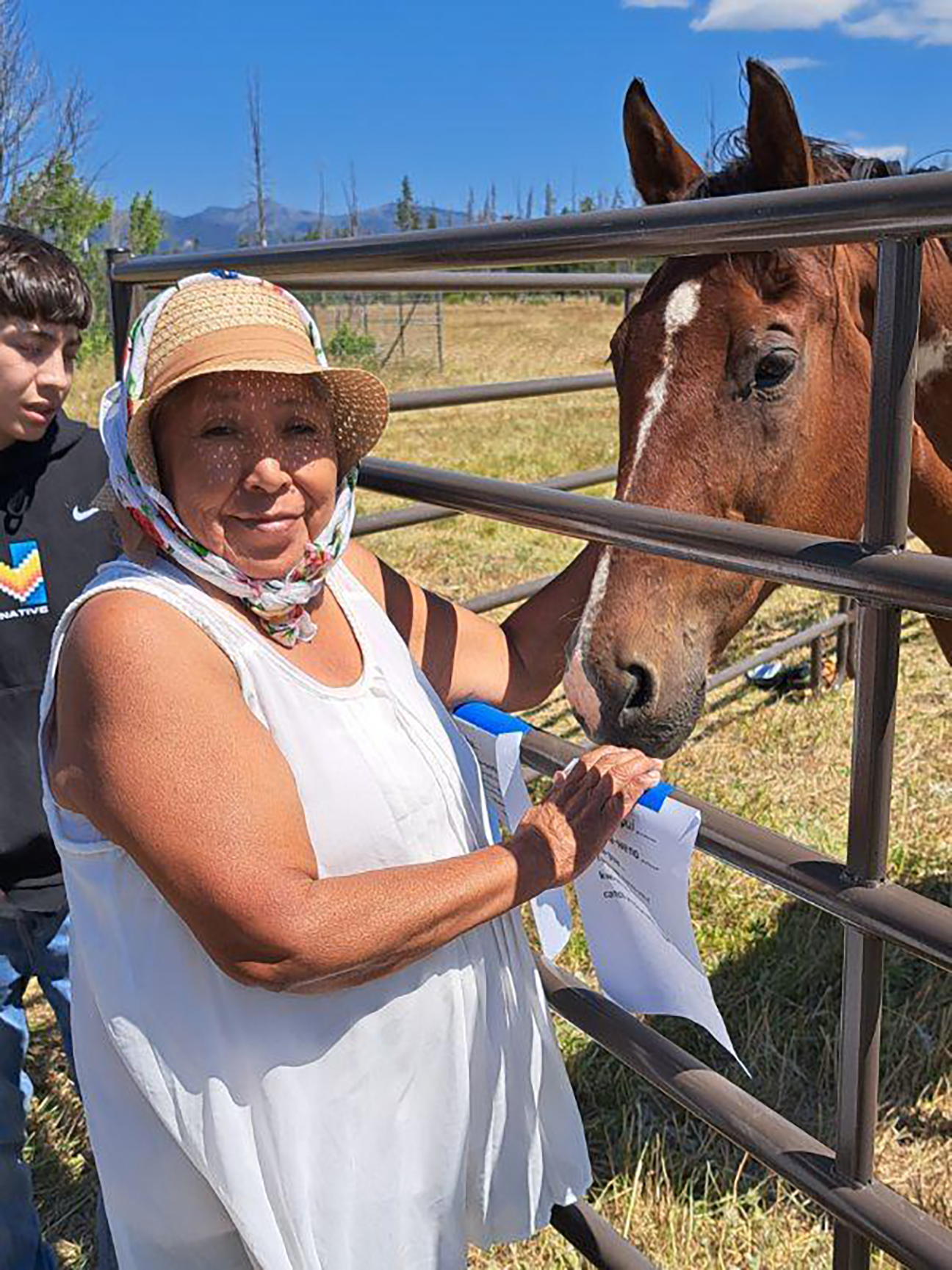
Jim St. Martin/The Imprint
Elder Beulah Morgan, who is Paiute and Shoshone.
At the first day’s morning session, Beulah Morgan — an elder wearing a straw hat and a floral headscarf — introduced herself as part-Shoshone and part-Paiute, from the Duck Valley reservation. Morgan offered prayers in the Paiute language. She is related to most of the roughly two dozen children in attendance, either as a grandma or auntie, and had come to observe.
“When you’re close to horses, it just does something to your heart — you can go riding anytime and get away from other people, even family members if you’re not getting along with them,” she told the Burns Paiute children.
Next, the kids were split into two groups by age to meet their partners: horses Callie, Apache, Jack, and a miniature pony, Peanut. The majestic creatures graciously accepted affectionate strokes from timid hands.
A Paiute language lesson composed by elder Morgan — who is a fluent Paiute speaker — hung on surrounding hand railings detailing the words: Puku for horse, Pakiada for cowboy, Naduno’o for saddle, and Wahaba for hay.
“Horses can be your very best friend. Practice your Paiute on these horses,” Morgan instructed. “They’re not going to say anything back to judge you.”
There were other firsts for the Burns Paiute youth. The camp, attended by over 40 community members, offered equine therapy alongside archery, beading, and tipi races.
One child asked why horses were important to their tribe. St. Martin responded with a lesson in history: the tribe’s lands at the foothills of the Strawberry Mountains were once a hub for Indigenous people who traded goods with other Paiute bands. Horses were among the goods traded, and considered significant gifts when given to an ally or family member.
“Wow, that’s big!” exclaimed a small child, listening intently. A fit of giggles erupted when next the paint horse Apache shoved his brown muzzle into the child’s face.
“This isn’t as scary as I thought it’d be,” said one teen as he brushed the coat of a mare named Callie, whose big chocolate eyes caught the gaze of many children nearby.
As the session wound down, the kids stood in a circle and took turns identifying how they felt about their time with the horses, on a scale from one to 10. Their answers topped the charts, and included “12,” “99” and “6,000.” The lowest score was eight. The child’s reason? “Because I didn’t ride.”
Twelve-year-old Peyton Larae Sam — the daughter of the tribe’s mental health worker who led the youth group at the camp — was one of the first children to ride. She was later crowned Powwow Queen for Burns Paiute Tribe, reciting part of her speech in Paiute.
“It’s not that scary to be around horses for me because I grew up around them,” Peyton said. “They just help with stress. You can trust them. If you need to get something out, horses will take it in. They’ll help you a lot, almost like a therapist.”
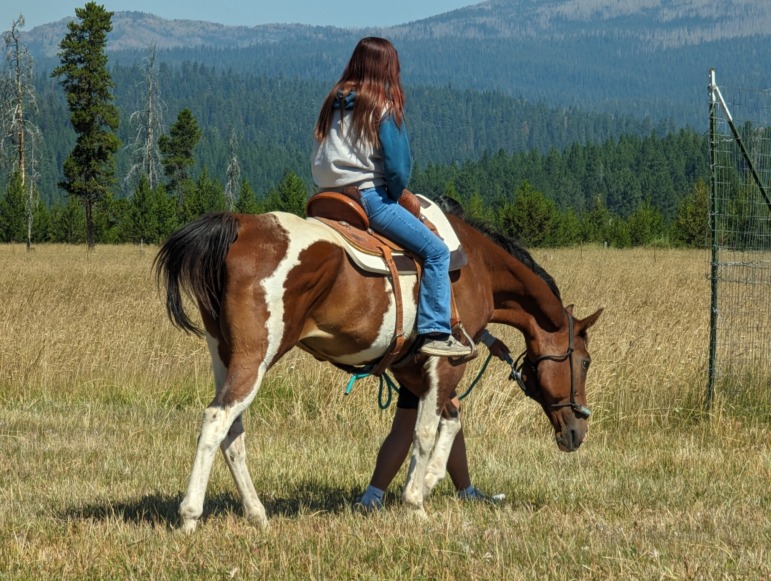
Nancy Marie Spears/The Imprint
Peyton Larae Sam, 12, rides her chosen horse, Apache.
Peyton described an early loss, a cousin who had moved away, and how she sought comfort and connection to a cherished family member.
“One horse just came up and laid its head on me,” she recalled. “And it felt relieving almost, to have everything go away. Like, the horse took it away from me. Being around them makes me happy, and helps me feel connected more to my culture and everything.”
Listen to the documentary podcast for this project, and view a gallery of photographs by visual storyteller Josué Rivas.
***
The Imprint is an independent, nonprofit daily news publication dedicated to covering child welfare, juvenile justice, mental health and educational issues faced by vulnerable children and families.
Voices of Monterey Bay is a not-for-profit bilingual news organization serving Monterey and Santa Cruz counties, providing a central location for people who have been ignored by the traditional media to express themselves or to report news from their neighborhoods.


